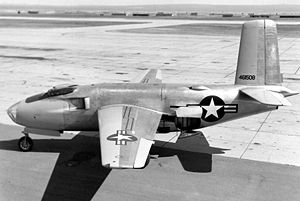Douglas XB-43
| Douglas XB-43 Jetmaster | |
|---|---|
 XB-43 prototype on the ground |
|
| Type: | Prototype of a bomber |
| Design country: | |
| Manufacturer: | |
| First flight: |
May 17, 1946 |
| Commissioning: |
Flight tests ended in 1953 |
| Number of pieces: |
2 |
The Douglas XB-43 Jetmaster (factory designation Model 469) was a jet-propelled experimental bomber of the USAAF from 1946. It was originally based on the Douglas XB-42 , whose piston engines were powered by two jet engines of the type General Electric J35-GE-3 (factory designation TG- 180) were replaced. The cockpit glazing was also taken over from the XB-42.
history
The project was already discussed in October 1943 by Douglas and the USAAF and the USAAF changed the XB-42 contract on March 31, 1944 and ordered two prototypes . Due to time constraints, the first prototype (USAAF serial number 44-61508) was converted from a static test cell of the XB-42. However, the first flight was delayed due to the late completion of the engines and damage to the machine when the engines were idling, during which the compressor blades came loose and penetrated the fuselage. The eight-minute first flight with Bob Brush and Russel Thraw on board was only possible on May 17, 1946. Further testing showed the lack of reliability of the drive and cracks in the plexiglass nose due to temperature fluctuations.
The second prototype (44-61509) was renamed the YB-43 Versatile II and got a plywood nose. It took off on its maiden flight on May 13, 1947 and was used for various engine test series. One of the jet engines was removed and replaced by a J47 test engine. The first J35-GE-3 engine was able to compensate for a failure of the test engine. In the case of the YB-43, the glass aircraft nose of the XB-43 was also adopted.
The trials ran until the end of 1953. The planned production of 13 pre-series machines was stopped and the North American B-45 was given preference. The Smithsonian Museum received the machine in June 1954 . By the end of 2010, the aircraft was dismantled together with an XB-42 in the Paul Garber Facility in Suitland , Maryland . Then it was transported to Dayton to the National Museum of the United States Air Force to be restored there. The first machine ended up as a target for target practice.
The XB-43 was the first complete jet-propelled bomber in the United States . The engines generated a thrust of 1700 kp each, with the thrust tubes merging at the stern. As a result, if one of the engines failed, only a slight asymmetrical thrust occurred. At the stern, the lower rudder unit was removed, but the upper rudder unit was enlarged. Just before the wings was an air inlet for the engines on each side. The machine could carry a bomb load of up to 2722 kg and had two remote-controlled 12.7 mm machine guns on the rear fuselage. The XB-43, however, never flew armed.
Technical specifications
| Parameter | Data |
|---|---|
| crew | 2 (pilot, copilot) |
| length | 15.60 m |
| span | 21.69 m |
| Wing area | 52.30 m² |
| height | 7.39 m |
| Empty mass | 9,877 kg |
| Max. Takeoff mass | 17,932 kg |
| Marching speed | 502 km / h |
| Top speed | 829 km / h |
| Service ceiling | 11,735 m |
| Range | 1,770 km |
| Engines | 2 × General Electric J35-GE-3 (TG-180) with 16.67 kN thrust each |
| Armament | 2 × remote-controlled 12.7 mm machine guns, 2,722 kg bombs |
gallery
Web links
Individual evidence
- ↑ FlugRevue September 2011, pp. 82–85, Dynamic Duo - Douglas XB-42 and XB-43


